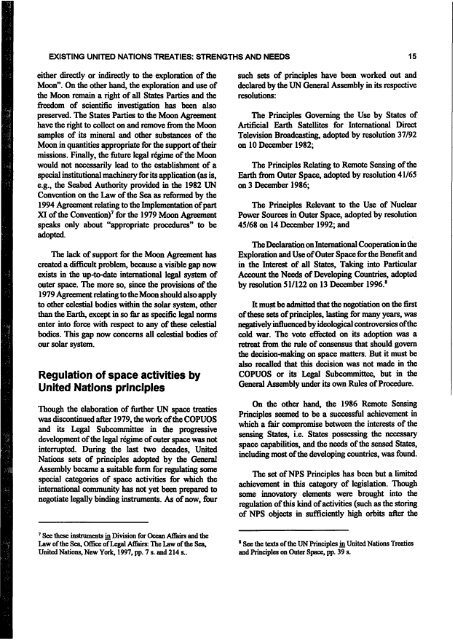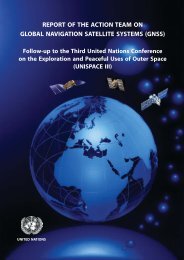Proceedings of the Workshop - United Nations Office for Outer ...
Proceedings of the Workshop - United Nations Office for Outer ...
Proceedings of the Workshop - United Nations Office for Outer ...
- No tags were found...
Create successful ePaper yourself
Turn your PDF publications into a flip-book with our unique Google optimized e-Paper software.
EXISTING UNITED NATIONS TREATIES: STRENGTHS AND NEEDS 15ei<strong>the</strong>r directly or indirectly to <strong>the</strong> exploration <strong>of</strong> <strong>the</strong>Moon”. On <strong>the</strong> o<strong>the</strong>r hand, <strong>the</strong> exploration and use <strong>of</strong><strong>the</strong> Moon remain a right <strong>of</strong> all States Parties and <strong>the</strong>freedom <strong>of</strong> scientific investigation has been alsopreserved. The States Parties to <strong>the</strong> Moon Agreementhave <strong>the</strong> right to collect on and remove from <strong>the</strong> Moonsamples <strong>of</strong> its mineral and o<strong>the</strong>r substances <strong>of</strong> <strong>the</strong>Moon in quantities appropriate <strong>for</strong> <strong>the</strong> support <strong>of</strong> <strong>the</strong>irmissions. Finally, <strong>the</strong> future legal régime <strong>of</strong> <strong>the</strong> Moonwould not necessarily lead to <strong>the</strong> establishment <strong>of</strong> aspecial institutional machinery <strong>for</strong> its application (as is,e.g., <strong>the</strong> Seabed Authority provided in <strong>the</strong> 1982 UNConvention on <strong>the</strong> Law <strong>of</strong> <strong>the</strong> Sea as re<strong>for</strong>med by <strong>the</strong>1994 Agreement relating to <strong>the</strong> Implementation <strong>of</strong> partXI <strong>of</strong> <strong>the</strong> Convention)7 <strong>for</strong> <strong>the</strong> 1979 Moon Agreementspeaks only about “appropriate procedures” to beadopted.The lack <strong>of</strong> support <strong>for</strong> <strong>the</strong> Moon Agreement hascreated a difficult problem, because a visible gap nowexists in <strong>the</strong> up-to-date international legal system <strong>of</strong>outer space. The more so, since <strong>the</strong> provisions <strong>of</strong> <strong>the</strong>1979 Agreement relating to <strong>the</strong> Moon should also applyto o<strong>the</strong>r celestial bodies within <strong>the</strong> solar system, o<strong>the</strong>rthan <strong>the</strong> Earth, except in so far as specific legal normsenter into <strong>for</strong>ce with respect to any <strong>of</strong> <strong>the</strong>se celestialbodies. This gap now concerns all celestial bodies <strong>of</strong>our solar system.Regulation <strong>of</strong> space activities by<strong>United</strong> <strong>Nations</strong> principlesThough <strong>the</strong> elaboration <strong>of</strong> fur<strong>the</strong>r UN space treatieswas discontinued after 1979, <strong>the</strong> work <strong>of</strong> <strong>the</strong> COPUOSand its Legal Subcommittee in <strong>the</strong> progressivedevelopment <strong>of</strong> <strong>the</strong> legal regime <strong>of</strong> outer space was notinterrupted. During <strong>the</strong> last two decades, <strong>United</strong><strong>Nations</strong> sets <strong>of</strong> principles adopted by <strong>the</strong> GeneralAssembly became a suitable <strong>for</strong>m <strong>for</strong> regulating somespecial categories <strong>of</strong> space activities <strong>for</strong> which <strong>the</strong>international community has not yet been prepared tonegotiate legally binding instruments. As <strong>of</strong> now, foursuch sets <strong>of</strong> principles have been worked out anddeclared by <strong>the</strong> UN General Assembly in its respectiveresolutions:The Principles Governing <strong>the</strong> Use by States <strong>of</strong>Artificial Earth Satellites <strong>for</strong> International DirectTelevision Broadcasting, adopted by resolution 37/92on 10 December 1982;The Principles Relating to Remote Sensing <strong>of</strong> <strong>the</strong>Earth from <strong>Outer</strong> Space, adopted by resolution 41/65on 3 December 1986;The Principles Relevant to <strong>the</strong> Use <strong>of</strong> NuclearPower Sources in <strong>Outer</strong> Space, adopted by resolution45/68 on 14 December 1992; andThe Declaration on International Cooperation in <strong>the</strong>Exploration and Use <strong>of</strong> <strong>Outer</strong> Space <strong>for</strong> <strong>the</strong> Benefit andin <strong>the</strong> Interest <strong>of</strong> all States, Taking into ParticularAccount <strong>the</strong> Needs <strong>of</strong> Developing Countries, adoptedby resolution 51/122 on 13 December 1996.8It must be admitted that <strong>the</strong> negotiation on <strong>the</strong> first<strong>of</strong> <strong>the</strong>se sets <strong>of</strong> principles, lasting <strong>for</strong> many years, wasnegatively influenced by ideological controversies <strong>of</strong> <strong>the</strong>cold war. The vote effected on its adoption was aretreat from <strong>the</strong> rule <strong>of</strong> consensus that should govern<strong>the</strong> decision-making on space matters. But it must bealso recalled that this decision was not made in <strong>the</strong>COPUOS or its Legal Subcommittee, but in <strong>the</strong>General Assembly under its own Rules <strong>of</strong> Procedure.On <strong>the</strong> o<strong>the</strong>r hand, <strong>the</strong> 1986 Remote SensingPrinciples seemed to be a successful achievement inwhich a fair compromise between <strong>the</strong> interests <strong>of</strong> <strong>the</strong>sensing States, i.e. States possessing <strong>the</strong> necessaryspace capabilities, and <strong>the</strong> needs <strong>of</strong> <strong>the</strong> sensed States,including most <strong>of</strong> <strong>the</strong> developing countries, was found.The set <strong>of</strong> NPS Principles has been but a limitedachievement in this category <strong>of</strong> legislation. Thoughsome innovatory elements were brought into <strong>the</strong>regulation <strong>of</strong> this kind <strong>of</strong> activities (such as <strong>the</strong> storing<strong>of</strong> NPS objects in sufficiently high orbits after <strong>the</strong>7 See <strong>the</strong>se instruments in Division <strong>for</strong> Ocean Affairs and <strong>the</strong>Law <strong>of</strong> <strong>the</strong> Sea, <strong>Office</strong> <strong>of</strong> Legal Affairs: The Law <strong>of</strong> <strong>the</strong> Sea,<strong>United</strong> <strong>Nations</strong>, New York, 1997, pp. 7 s. and 214 s..8 See <strong>the</strong> texts <strong>of</strong> <strong>the</strong> UN Principles in <strong>United</strong> <strong>Nations</strong> Treatiesand Principles on <strong>Outer</strong> Space, pp. 39 s.
















